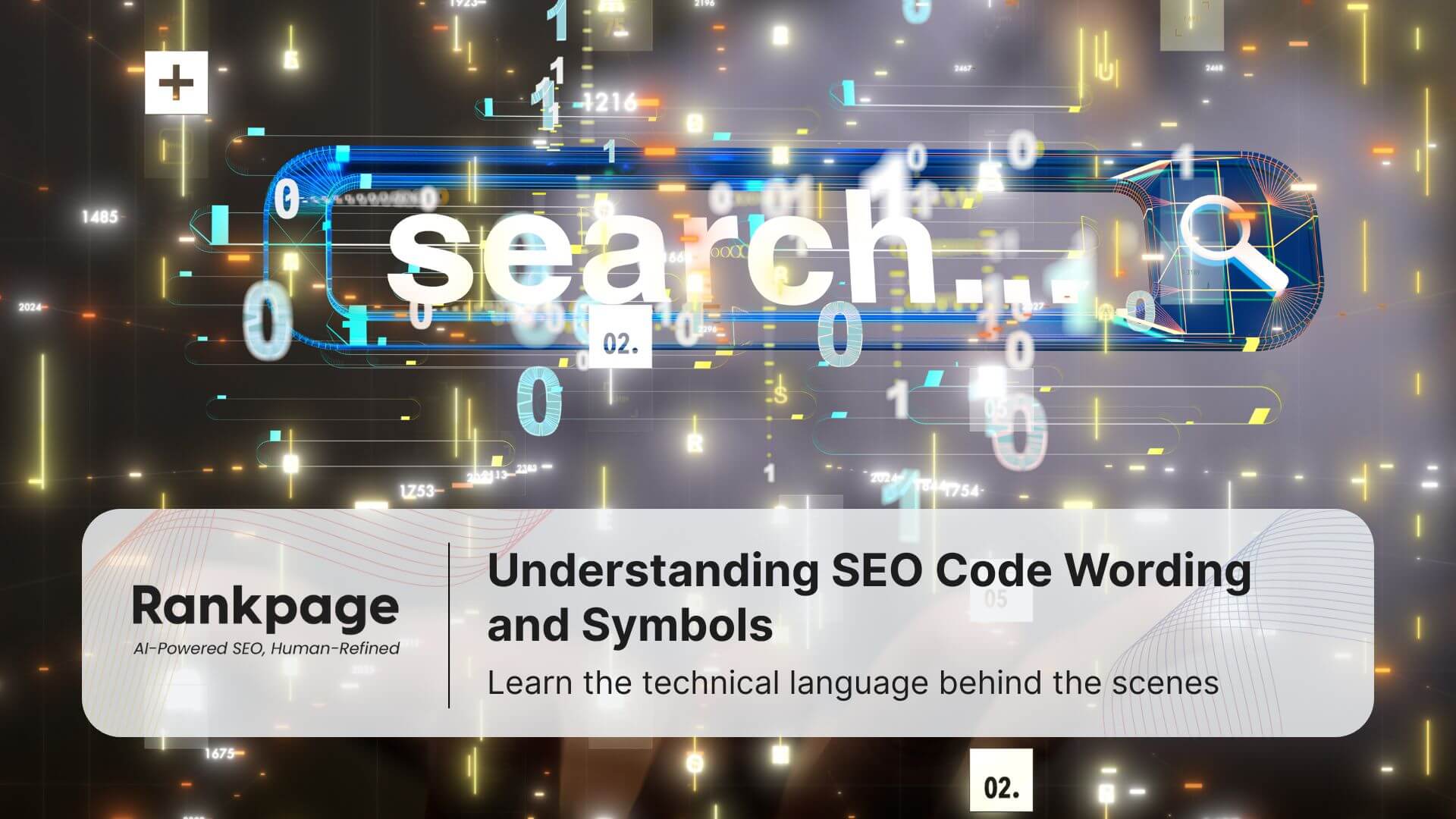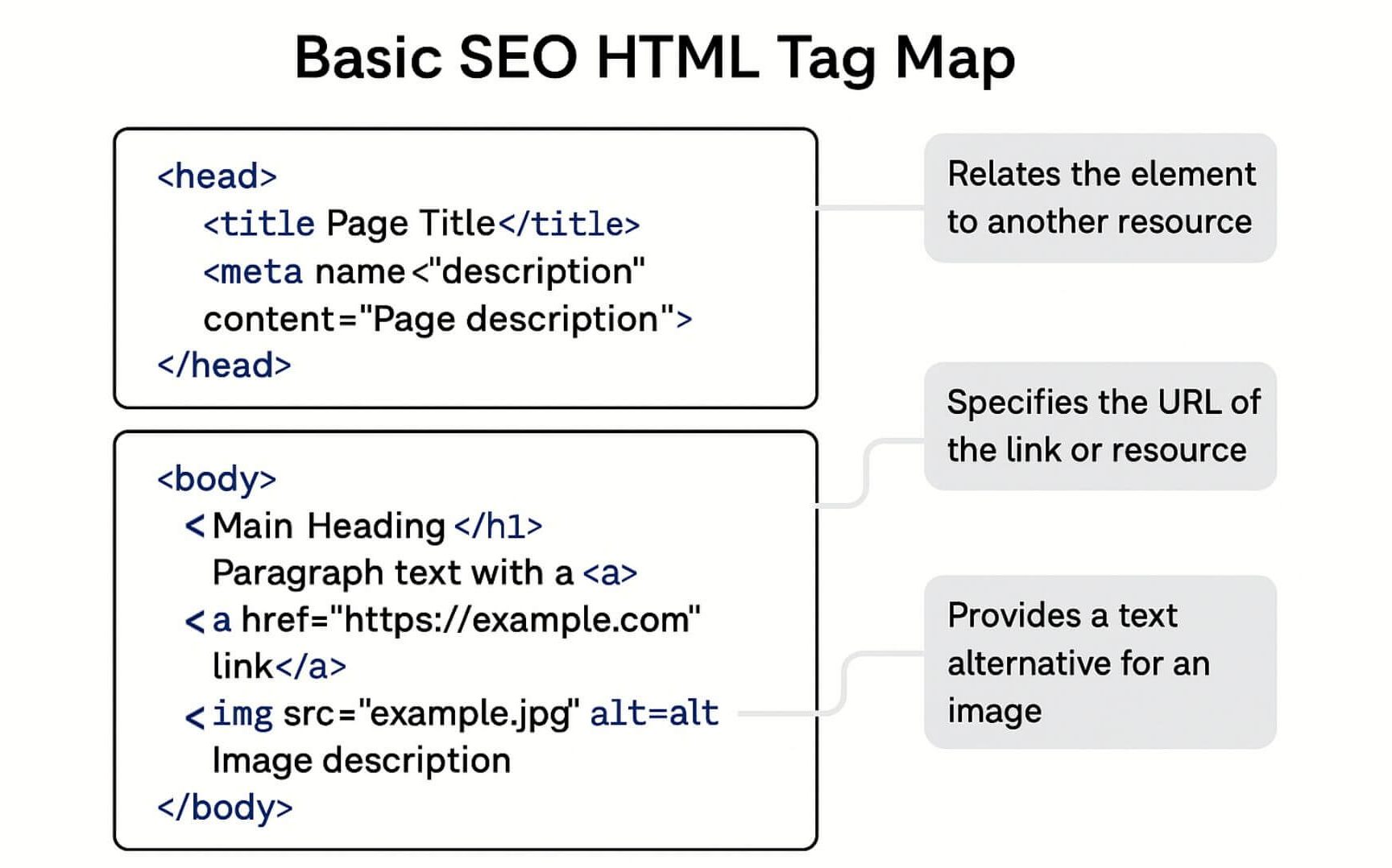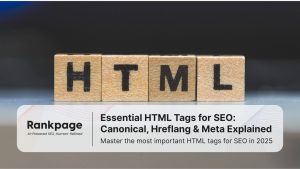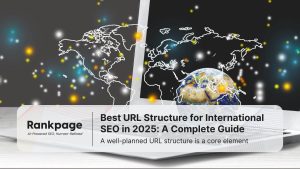Key Takeaways
- HTML tags like <title>, <meta>, and <a> are critical for communicating SEO intent to search engines.
- Attributes such as rel=, href=, and name= define the relationship, destination, or identity of tags.
- Structured use of heading tags <h1> to <h6> guides both bots and readers through your content.
- Symbols like /, ?, &, and = play functional roles in URL parameters and SEO-friendly link structures.
- Understanding these elements empowers you to control indexing, readability, and search engine interpretation.
Search engines don’t see your site like humans do, they read your code. If you want your site to be discovered, indexed, and ranked correctly, you need to understand how HTML code and SEO symbols influence search engines. This guide breaks down the technical language behind the scenes so marketers, developers, and content creators can collaborate better and build smarter websites.
Table of Contents
What Are SEO HTML Tags?
HTML tags tell search engines what your content means.
They’re instructions enclosed in angle brackets < > and are the foundation of every web page.
Common SEO-relevant tags include:
Tag | Purpose | Example |
<title> | Sets page title shown in search results | <title>SEO Agency Malaysia</title> |
<meta name="description"> | Adds a summary for search snippets | <meta name="description" content="Best SEO Specialist in Malaysia"> |
<a> | Creates a clickable hyperlink | <a href="https://example.com">Visit</a> |
<img> | Displays an image and includes SEO-friendly alt text | <img src="shoes.jpg" alt="Red Sneakers"> |
<strong> | Emphasises important keywords (Bold) | Get <strong>free shipping</strong> now! |
Further understanding: Essential HTML Tags for SEO: Canonical, Hreflang & Meta Explained (2025 Guide)
Important SEO Attributes Explained
Attributes add specific instructions or context to HTML tags. In SEO, they guide how search engines interpret and interact with your web content.
1. rel=
The rel (short for “relationship”) attribute defines the relationship between the current page and the linked resource. Used mainly for SEO, security, and link behavior control.
Common rel values used in SEO:
rel value | Meaning / Use |
nofollow | Tells search engines not to pass link authority (use for sponsored or untrusted links). Example: <a rel="nofollow" href="https://external-site.com"> |
noopener | Improves site security and performance by preventing the new tab from accessing the original page via JavaScript. Example: <a href="https://example.com" target="_blank" rel="noopener noreferrer">Visit Site</a> |
noreferrer | Hides the referring URL from the target page to protects user privacy Example: <a href="https://example.com" target="_blank" rel="noopener noreferrer">Visit Site</a> |
sponsored | Marks paid or affiliate links. Example: <a rel="sponsored" href="#"> |
ugc | Indicates user-generated content (blog comments, forums). Example: <a rel="ugc" href="#"> |
canonical | Tells search engines the preferred version of a page if multiple versions exist. Example: <link rel="canonical" href="https://example.com/page" /> |
alternate | Signals that the linked page is an alternative version (like different language/region) of the current page. Example: <link rel="alternate" hreflang="en-my" href="https://example.com/my/" /> |
2. href=
The href (short for “hypertext reference”) attribute points to the web page you want the link to open.
Used inside the <a> (anchor) tag to tell browsers where the link should go.
Example: <a href="https://www.rankpage.com.my/">Visit Rankpage</a>3. src=
Defines the file path for images, scripts, or videos.
Example: <img src="logo.png" alt="Company Logo">4. alt=
Used inside image tags to describe the image, important for accessibility and SEO.
Example: <img src="banner.jpg" alt="2025 SEO Specialist">5. name= and content=
Used in <meta> tags to define things like description, viewport, charset, and so on.
Example: <meta name="viewport" content="width=device-width, initial-scale=1.0">Fact: Attributes inside HTML tags are unordered, they all sit inside the <a …> tag and are read equally by the browser.
Understanding SEO Symbols and URL Parameters
Symbols used in URLs and HTML code are often misunderstood. Here’s what they mean:
Symbol | Meaning | Common Use |
/ | Separates directories | example.com/shoes/sneakers |
? | Begins URL parameters | example.com?page=2 |
& | Separates multiple parameters | ?utm_source=google&utm_medium=cpc |
= | Assigns a value to a parameter | color=blue |
# | Anchor to a specific section | example.com/about#team |
These symbols help define tracking links, filter URLs, and support dynamic content without creating duplicate content.
Heading Tags and Content Hierarchy
Search engines use heading tags to understand the structure, priority, and context of content on your page. Just like an outline in a report, heading tags help both bots and humans navigate content logically.
- <h1>: Main title of the page, use only once per page.
- <h2>: main sections of your content
- <h3>–<h6>: These are used for more detailed subtopics or groupings, FAQs, or smaller groupings.
Example:
<h1>Ultimate SEO Guide for 2025</h1>
<h2>What Is SEO?</h2>
<h3>On-Page SEO Basics</h3>
<h3>Technical SEO Essentials</h3>
Tip: Avoid skipping levels (don’t jump from <h1> to <h4>) as it may confuse both users and bots.
Symbols in HTML Content (That Aren’t Just Decoration)
These are called HTML entities and are used to display characters that would otherwise be read as code.
Symbol | Code | Purpose |
| Non-breaking space | Prevents line breaks in text |
& | & | Used in HTML to show ampersand |
< and > | < and > | Shows angle brackets on page |
" | “ | Displays quotation marks in HTML |
How Developers and Marketers Should Collaborate
- Marketers need to understand the purpose of each HTML tag and where it should be placed for SEO impact.
- Developers should ensure tags are implemented consistently and correctly in the site’s codebase or CMS templates.
- Use shared documentation to align on tag usage, naming conventions, and SEO best practices.
- Audit implementation together using browser Inspect tools or SEO plugins (like MozBar, Ahrefs Toolbar) to verify live pages.
Final Thoughts: Speak Google’s Language
You don’t need to be a developer to understand how HTML tags and SEO attributes shape your website’s visibility. But knowing how to use them correctly gives your team a real competitive edge.
If you’re looking for a SEO agency that bridges the gap between marketers and developers, Rankpage offers tailored audits, implementation support, and training to elevate your technical SEO game in the right way.
Talk to our SEO experts today and build a search-ready foundation for your business.
Frequently Asked Questions About SEO Code Wording and Symbols
What’s the difference between a tag and an attribute?
A tag is the instruction (like <a>), while an attribute gives it extra information (like href=).
Can I use multiple rel values?
Yes, separate them by a space: rel=”nofollow sponsored“.
Do symbols in URLs affect SEO?
Yes. Clean, keyword-friendly URLs with correct use of ?, &, and / can improve readability and indexing.
Should I manually edit these tags?
Yes, but only if you know how. Use CMS plugins or developer help for complex edits.
What tools can help me check SEO tags?
Try Screaming Frog, Ahrefs Site Audit, MozBar, or Chrome DevTools.
Do heading tags (H1–H6) only affect readability, or do they impact SEO directly?
They impact both. Heading tags improve readability and help search engines understand your page’s structure and main topics, boosting SEO relevance.






